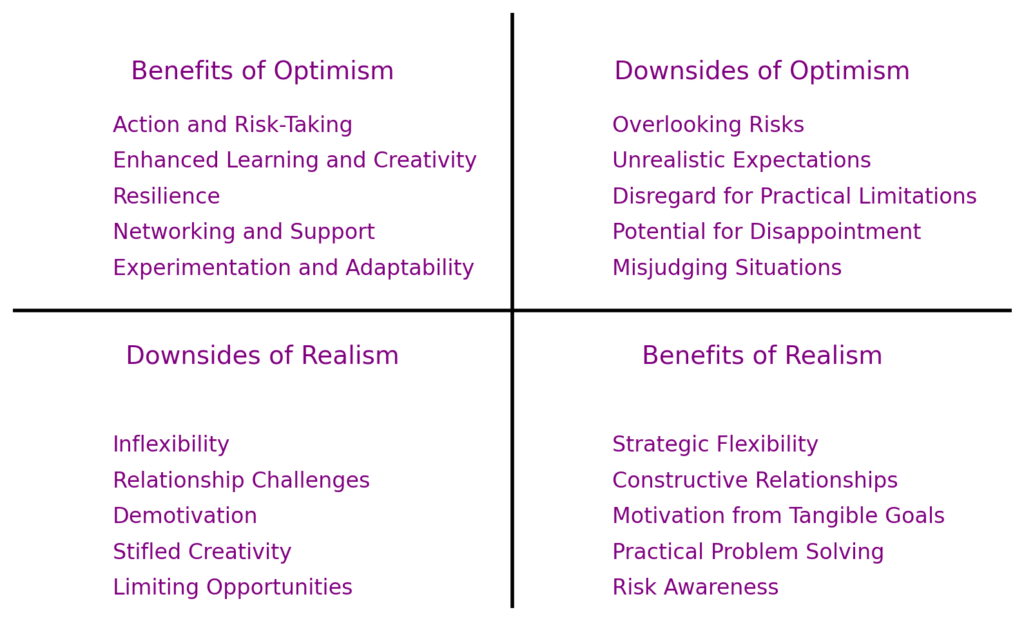

Benefits of Optimism
1. Action and Risk-Taking: Optimists often dive into projects with enthusiasm, willing to take risks that might intimidate others. This bold approach can lead to significant breakthroughs and innovations.
2. Enhanced Learning and Creativity: Optimism fuels a positive mindset that is conducive to learning and creativity. Optimists are more likely to engage in creative problem-solving, seeing potential where others might see dead-ends.
3. Resilience: Optimism is a key component of resilience. It allows individuals to bounce back from setbacks and maintain a positive outlook, even in the face of adversity.
4. Networking and Support: Optimists tend to attract a network of supportive and like-minded individuals. This positive energy not only fosters personal growth but also creates a support system that can be crucial in challenging times.
5. Experimentation and Adaptability: An optimistic disposition encourages experimentation and adaptability. Optimists are more likely to try new things and adapt to changes, viewing them as opportunities rather than threats.
Downsides of Realism
1. Limiting Opportunities: Realists might miss out on opportunities due to their focus on practicalities and limitations. This perspective can sometimes prevent them from taking chances that could lead to significant gains.
2. Stifled Creativity: A realistic viewpoint might inhibit creativity. By focusing too much on what is practical or probable, realists may overlook innovative solutions.
3. Demotivation: Realism can lead to demotivation, especially if the focus is constantly on the hurdles or the less-than-ideal aspects of a situation.
4. Relationship Challenges: Realists might face challenges in relationships, particularly with more optimistic counterparts, due to their pragmatic and sometimes pessimistic outlook.
5. Inflexibility: A strong focus on realism can result in inflexibility, as adapting to new or unforeseen circumstances may be more difficult for those who are deeply rooted in practical realities.
Downsides of Optimism
1. Overlooking Risks: Optimists might overlook or underestimate risks, leading to decisions that are not well-informed or prepared for potential challenges.
2. Unrealistic Expectations: Excessive optimism can foster unrealistic expectations, setting one up for disappointment if things do not pan out as hoped.
3. Disregard for Practical Limitations: Optimists may sometimes disregard practical limitations, leading to overcommitment or the pursuit of unfeasible goals.
4. Potential for Disappointment: High expectations fueled by optimism can lead to disappointment if outcomes do not match the optimistic projections.
5. Misjudging Situations: A highly optimistic outlook can sometimes lead to misjudging situations, underestimating difficulties, or failing to plan adequately for possible setbacks.
Benefits of Realism
1. Risk Awareness: Realists are typically more aware of risks, allowing for better preparedness and contingency planning.
2. Practical Problem Solving: A realistic approach fosters practical problem-solving skills. Realists tend to focus on tangible solutions that are feasible and grounded in reality.
3. Motivation from Tangible Goals: Realists are often motivated by tangible, achievable goals. This focus on realistic objectives can drive consistent progress and achievement.
4. Constructive Relationships: Realism can lead to more constructive relationships, particularly in professional settings, as realists tend to set clear, achievable expectations.
5. Strategic Flexibility: Realism does not necessarily mean rigidity. In fact, a realistic outlook can foster strategic flexibility, allowing individuals to adjust plans and strategies based on practical assessments of changing circumstances.
Both optimism and realism have their distinct advantages and disadvantages. Striking a balance between the two can lead to a more well-rounded approach to life and decision-making, combining the best of both worlds: the hope and drive of optimism with the groundedness and practicality of realism.
INVERT:
Charlie Munger, the renowned investor and vice chairman of Berkshire Hathaway, is well-known for his concept of “inversion,” a problem-solving strategy. Inversion involves approaching a problem backward or from the opposite end of the traditional starting point. It’s about looking at what you want to avoid and then figuring out how to avoid it. This concept can be applied to the balance between optimism and realism, particularly in decision-making and strategic planning.
Applying Inversion to Optimism and Realism
For the Overly Optimistic:
- Inversion Focus: Instead of focusing on what could go right, they should consider what could go wrong. This helps in identifying potential pitfalls and risks they might typically overlook.
- Risk Management: By considering the worst-case scenarios, optimists can create contingency plans, thus grounding their optimism with a dose of realism.
- Setting Realistic Goals: By inverting their tendency to set overly ambitious goals, they can aim for targets that are challenging yet achievable, reducing potential disappointment.
For the Overly Realistic:
- Inversion Focus: Instead of constantly looking at the limitations and risks, they should contemplate what opportunities might be missed by being too cautious.
- Encouraging Creativity: By considering the best-case scenarios, realists can open themselves up to more creative and innovative solutions, breaking free from the confines of their usual pragmatism.
- Expanding Comfort Zones: Inverting their focus on practicality can lead to taking calculated risks, potentially leading to greater rewards.
Practical Steps for Inversion
- Reflection and Self-Awareness: Acknowledge your natural inclination towards either optimism or realism. Self-awareness is key in understanding how to apply inversion.
- Seeking Alternative Perspectives: Engage with individuals who hold a different outlook. For optimists, this means consulting with more pragmatic individuals, and vice versa for realists.
- Scenario Analysis: Actively practice thinking through both positive and negative outcomes of any given situation. For optimists, emphasize the negative outcomes more, and for realists, the positive ones.
- Balance in Decision Making: Strive for decisions that incorporate both the hopefulness of optimism and the groundedness of realism. This might mean tempering high expectations with practical considerations or infusing a realistic plan with a bit more ambition and vision.
In essence, Munger’s inversion idea, when applied to the dichotomy of optimism and realism, encourages individuals to step outside their comfort zones and adopt a more balanced, comprehensive approach to thinking and problem-solving. This can lead to more robust, well-rounded decisions and strategies, both in personal and professional contexts.



